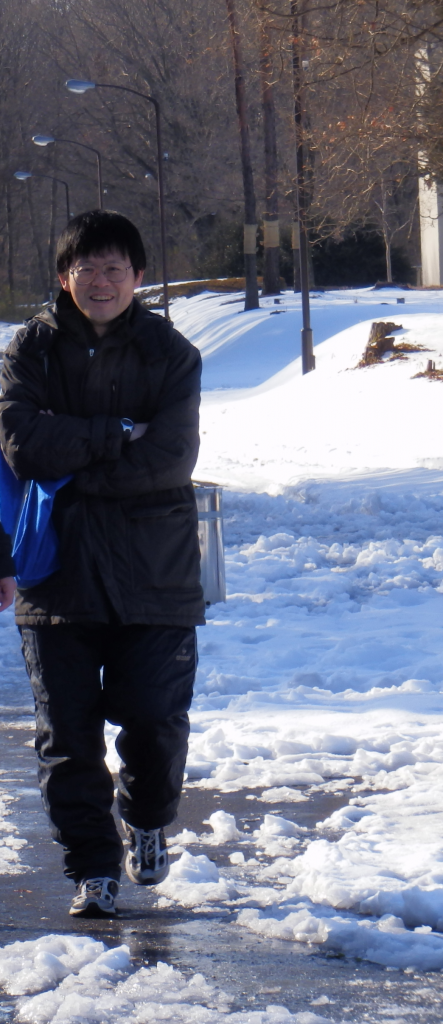昨年秋、YouTubeにHomePageを開設しました。(‘13,11,20)
今回、AMIRA等のソフトの使用法を示す動画を整理しました。ご利用ください。(‘14,06,25)
|
||||
|
昨年秋、YouTubeにHomePageを開設しました。(‘13,11,20)
今回、AMIRA等のソフトの使用法を示す動画を整理しました。ご利用ください。(‘14,06,25) 海外君、名古さんの論文で作成した胃の立体像が解剖学雑誌Anatomical Record 297巻5号の表紙に採用されるとともに、ビデオを結果として示すことのできるAR WOW-Video Articleの第1号の論文として採用されました。 N. Kaigai, A. Nako, S. Yamada, C. Uwabe, K. Kose and T. Takakuwa Anat RecはAmerican Association of Anatomists (AAA)の公認雑誌で、100年以上の発行歴のある由緒ある雑誌です。永く世界の医学、解剖学、発生学の分野を牽引してきました。本雑誌は、さらに、最近のe-Page技術を取り入れたWOWという雑誌を本号から採用しました。これは、ビデオが論文の結果として重要な役割を果たす際にそのビデオが永久に保存できるようにしたものです。その第1号の論文として、海外君の胃の形態形成と動きについての論文が選ばれました。 Editorialでは、”Human Embryos are Turning on the e-Pages of AR”(ヒト胚子がARのe-Pageに灯をともす…)という題で, インタビューを受け、私たちの予想以上に讃えていただきました。(Anat Rec 297(5) ; 799–801, 2014) Our rationale for imaging the human stomach during development.“All of the authors are well-versed with the fact that the stomach develops as the local widening of the foregut at Carnegie Stage (CS) 13, as well as the morphology and position of the stomach in adults. But what are the developmental dynamics from the former to the latter? While I (Dr. Takakuwa) was a university student, I read a textbook that explained that the developmental dynamics of the stomach follow the order of linear movement along the caudal direction, rotation around the longitudinal (Z) axis, and rotation around the dorsoventral (X) axis. This explanation aroused my curiosity with regard to the position of the abdominal organs around the stomach, such as the esophagus, pancreas, and duodenum, which are restricted in their positions after CS17. For example, around CS20, movement of the stomach is restricted at both its entrance (cardia) and the exit (pyloric antrum) near the mid-sagittal plane. We designed our study to sort out the dynamic process that places the stomach in its definitive position in the abdomen. Accordingly, we analyzed the external morphology and morphometry of the human embryonic stomach, as well as documented its precise 3D movements, using magnetic resonance (MR) imaging data of human embryos in the “Kyoto Collection”. We discovered that the line connecting the cardia and the pyloric antrum of the stomach does not rotate around the dorsoventral (X) axis, as widely believed, but rotates around the transverse (Y) axis. The stomach “appears” to move towards the left, laterally and caudally, as deflection and differential growth progresses. We found that the developmental morphology of the three-dimensionally reconstructed stomach was not “analogous” to that of adults or as described in recent textbooks. Rather, we found that the stomach’s developmental morphology is as documented in a study a century before (Lewis 1912), in which the stomach was precisely hand drawn by a special artist [note added by Editor: Lewis studied the stomachs of five human embryos that were 10 mm and 45 mm in length; Harvard Embryological Collection, Series 1000]. We are gratified that our MR imaging data of embryos enhance the value of the Kyoto Collection, not only as archives of historical specimens but also as useful research resources for the future.” Contributed by Kaigai and colleagues, Kyoto University, Graduate School of Medicine. 海外くんの卒業論文がAnatomical recordに掲載されました。卒業後、 Office assistantとして2年かけて仕上げてくれました。教科書には、胃の動きは”下降”、”頭尾軸に対する回転”、”背腹軸に対する回転”と3つの動きにわけて説明されています。しかしながら実際の動きは立体空間的でありそう単純ではありませんでした。 8. Morphogenesis and three-dimensional movement of the stomach during the human embryonic period, 2014 May;297(5):791-7. doi: 10.1002/ar.22833.
 本研究の立体画像元データの一部はMorphoMuseuMに受諾されました。 20. Nako A, Kaigai N, Shiraki N, Yamada S, Uwabe C, Kose K, Takakuwa T, 3D models related to the publication: Morphogenesis of the stomach during the human embryonic period, MorphoMuseuM, in press ABSTRACTThe stomach develops as the local widening of the foregut after Carnegie stage (CS) 13 that moves in a dramatic and dynamic manner during the embryonic period. Using the magnetic resonance images of 377 human embryos, we present the morphology, morphometry, and three-dimensional movement of the stomach during CS16 and CS23. The stomach morphology revealed stage-specific features. The angular incisura and the cardia were formed at CS18. The change in the angular incisura angle was approximately 90° during CS19 and CS20, and was <90° after CS 21. The prominent formations of the fundus and the pylorus differentiate at around CS20. Morphometry of the stomach revealed that the stomach gradually becomes “deflected” during development. The stomach may appear to move to the left laterally and caudally due to its deflection and differential growth. The track of the reference points in the stomach may reflect the visual three-dimensional movement. The movement of point M, representing the movement of the greater curvature, was different from that of points C (cardia) and P (pyloric antrum). The P and C were located just around the midsagittal plane in all the stages observed. Point M moved in the caudal-left lateral direction until CS22. Moreover, the vector CP does not rotate around the dorsoventral axis, as widely believed, but around the transverse axis. The plane CPM rotated mainly around the longitudinal axis. The data obtained will be useful for prenatal diagnosis in the near future.  大雪でした 2/9~2/11, Photon Factory (つくば)で位相X線CTを用いて胚子撮像を行いました。関東地方は20年にぶりの大雪でしたが、無事終了しました。得られた画像は、胚子の詳細な内部観察に使用します。
 胚子をゲルで台座に固定したところ  研究の合間のひととき
金橋くんの修士学位審査が無事おわり、 昼食partyでお祝いしました。お疲れ様でした。(14.02.07) 論文題目;ヒト胚子期における肝臓形態形成異常の解析 A series of liver malformations in externally normal human embryos 英語論文として受諾されました。 18. Kanahashi T, Yamada S, Tanaka M, Hirose A, Uwabe C, Kose K, Yoneyama A, Takeda T, Takakuwa T, A novel strategy to reveal the latent abnormalities in human embryonic stages from a large embryo collection, Anatomical Record, 299,8-24,2016 10.1002/ar.23281(概要), *299(1),2016の表紙に採用されました。DOI: 10.1002/ar.23206 (cover page) ヒト胚子期における肝臓形態形成異常の解析 BACKGROUND 肝臓は胚子期に腹腔内最大の器官へ発達するとともに、造血や代謝等の胚子・胎児の成長にとって重要な役割を担う。ヒト胚子期における正常な肝臓の形態形成については我々の研究室が報告したが、形態形成異常についての報告はなされていない。肝臓は発生中に造血や胎児蛋白産生等の重要な機能を果たすことから、その形成不全は胚子・胎児の発育に影響を与える可能性が高く、子宮内胎児死亡に至る可能性がある。また、多くの外表奇形が流産の原因となることが報告されている一方で、外表奇形を伴わなわず流産に至る原因については明らかになっていない。今回、外表奇形を伴わないヒト胚子の中から、肝臓形成不全の可能性のある個体を抽出し、肝臓、並びに周辺器官の形態形成の特徴について明らかにする為に、詳細な解析を行なった。 METHODS 京都大学大学院医学研究科附属先天異常標本解析センターに保存されている外表奇形を伴わないヒト胚子から、MR顕微鏡で撮像された1156例 (Carnegie stage (CS)14~23)を対象とした。これらは、肝臓形態形成に異常の可能性があるものを抽出するため以下のスクリーニング法を用いて解析を行なった。1)肝臓体積を推定できる式を作成し、各胚子の肝臓体積推定値を算出。2)肝臓体積推定値が各CS平均±2SDを外れる個体を抽出した後、肝臓、並びに周辺器官についてMR画像や三次元再構築像により、形態観察を行ない、抽出した個体から肝臓形態形成異常の可能性が高いものを選抜。選抜個体については、MR顕微鏡よりも高解像度の位相コントラストX線CT(PCT)により再撮像を行ない、胚子内部の詳細な解析を加えた。 RESULTS 肝臓体積推定値によるスクリーニングから、体積推定値が各CS平均+2SD以上の個体が41例(CS14~23)、各CS平均-2SD以下が12例(CS19~21)得られた。計53例について形態観察を行ない、平均+2SD以上の個体41例からExtra-large群として8例(CS17~19)、平均-2SD以下12例からExtra-small群として7例(CS20~21)を選抜し、PCTで再撮像し、胚子内部の解析を行なった。肝臓の形態形成異常はExtra-small群7例全てで観察され、Extra-large群では8例中2例で観察された。Extra-small群7例は以下のように分類された。①肝臓無形成; 2例、②肝臓低形成; 4例、③右葉欠損; 1例。また、7例中5例で肝臓の他、周辺器官に形態形成異常の合併がみられた。Extra-large群では、2例中1例は肝臓のみに異常がみられ、臍帯静脈の拡張が観察された。残り1例は、肝臓並びに周辺器官に形態異常の合併がみられた。肝臓形態形成を認める胚子はCS18からCS21に限定しており、約1.7%(9/532)の割合で出現した。 CONCLUSIONS: 本研究では、外表奇形がない胚子に肝臓の形態形成異常をもつ集団が約1.7%存在する事を新たに示した。同集団は、肝機能不全の結果、子宮内胎児死亡に至る可能性が高く、早期流産の原因の一つになると考えられる。 英語論文 18. Kanahashi T, Yamada S, Tanaka M, Hirose A, Uwabe C, Kose K, Yoneyama A, Takeda T, Takakuwa T, A novel strategy to reveal the latent abnormalities in human embryonic stages from a large embryo collection, Anatomical Record, 299,8-24,2016 10.1002/ar.23281(概要), *299(1),2016の表紙に採用されました。DOI: 10.1002/ar.23206 (cover page) |
||||